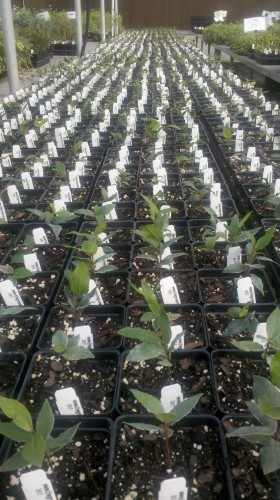Bays are one of our favorite herbs to grow, as well as one of our most popular products for obvious reasons: It’s a terrific culinary herb that adds a great, savory flavor to your favorite dish, they can be pruned into beautiful topiaries, Bay oil is a natural insect repellent, and the plant can be used medicinally to cure a range of ailments. With all of these things to love about the noble Bay Tree, it’s still hard to be patient with its incredibly difficult germination process and slow growth. To fully appreciate how hard these wonderful plants are to cultivate and how special they are to own, we want to give you a glimpse at the early life cycle of the Bay.
Bays can be germinated from seed or propagated from cuttings. Each method has its own unique challenges, as it is often hard to find a specimen mature enough to take cuttings from and the seeds need meticulous care to germinate. Bay seeds must be obtained fresh and stratified before being sown. The process of stratification forces the plant embryo out of its natural dormancy phase, by simulating cold winter temperatures that would naturally allow the seed’s outer coat to soften and allow the embryo inside to break through. During this process the Bay seeds need to also be kept at a proper moisture level, as when left to dry out, they will not germinate. Once the stratification process is over and they are removed from refrigeration, the seeds need to continue to remain moist and must be sown immediately.
Bay seeds generally have a low germination rate due to their strict needs. Seeds with their pericarp removed (the tough outer seed layers, which are softened by stratification and moisture) only have about a 40% germination rate. In addition to being “needy seeds” and having a low chance of germination, it takes a very long time for the seeds to actually germinate, once planted. Taking roughly about fifty days to germinate, the seeds face a great chance of rotting before they are able to break through the soil. After germination, the plant has a tremendously slow growth rate and can take years to reach just a few feet in height. Grown in areas that mimic the Mediterranean climate that they are native to, like Southern California, the Bay can mature to a tree of twenty feet or more. In most areas though, Bays make a wonderful potted plant and may reach four or five feet high, but even this stature takes quite a while of growth.
Being a gardener means that you must be patient. It can be quite frustrating to put so much love and hard work into seeds that may not come to fruition, but when they do, it is a miraculous joy and triumph over mother nature. We hope that understanding the trials that a seed has to grow through just to get established and large enough to ship to your door, may help us all have patience with a plant like Bay. But believe us, they are more than well worth the wait!


How do you grow the bay? Will I get instructions?
Bay is a slow grower, but prefers well draining soil and full sun. Please refer to our product page for Bay and review “Briscoe’s Tips” for specific information on growing this wonderful culinary herb! You will also receive general instructions with your order, but we have made detailed growing tips available for each plant under the Briscoe’s Tips section of every product page on our site to give you the wealth of our knowledge for growing successful plants!